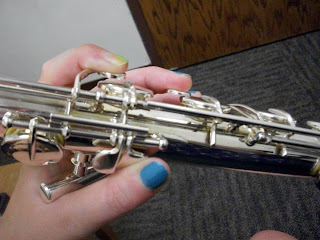Interview with a Bass Flute
A Music Zombie Exclusive!
Recently, Music Zombie had the chance to meet a Bass Flute. After some bargaining, and maybe just a little bit of blackmail, the Bass agreed to an interview. What follows is the transcript of that interview.
Music Zombie: Thank you so much for agreeing to speak with me. It's not everyday that I get the chance to meet such an unusual instrument.
Bass Flute: Well, I am not that unusual. But I suppose that I don't make as many appearances in bands and orchestras as my higher-pitched relatives. They like to be heard, I guess. I prefer to just support the low end of the section. Occasionally, I will take solos, but because I am hard to hear at times, I often need extra amplification from those nerdy sound-crew people. And, well, you know how they can be...they're all "Can you move closer to the microphone?"-this and "can you play any louder?"-that. Sheesh...
MZ: Still, you make an interesting sound. You really add something extra to flute choirs. More depth to the sound, certainly.
BF: I suppose. Did you know that I read the same music as C flutes, but the sound I produce is a full octave lower? Sort of the opposite direction that a piccolo will take. You know those piccolos like to shriek above the music a full octave higher than the flute. Haha! Squeaky little things!
MZ: Isn't it true, though, that you share some things in common with the piccolo, in terms of construction?
BF: Well, yes. Oftentimes, we are made without the extra keys as the foot joint (or completely missing the foot joint, as in the piccolo's case) and I lack trill keys. I don't suppose folks have any interest in hearing basses trill.
MZ: Say, what is the funny foot thing you've got there near your left hand key section?
BF: My crutch? Well, I'm glad you noticed! Because my tube is so large, and I am quite a bit heavier than the small flutes, this crutch allows my player a more comfortable hand position. Here, give it a try. You will notice that it feels more stable when your left hand has more support.
MZ: You're right! That feels pretty comfy! I did notice that your keys aren't really that much farther apart than on a regular flute, but the hands are more spaced apart. That means that your tube is much longer than a regular flute...but that is to be expected for a low-sounding instrument...care to elaborate?
BF: Exactly! Longer tubes equal lower tones. Again, compare me to the high-sounding, short-tubed piccolo! However, because my tube is so long, my head joint is usually built with a crook in it. This brings the hand closer to the player. This wasn't always the case. The great instrument designer, Theobald Boehm, made a straight model. It is reported to have great tone and power, but is really hard to hang on to while playing. So, most of us nowadays are given curves.
MZ: Fascinating! One more thing I couldn't help but notice--your lip plate has a wall on it! Tell me about that!
BF: Oh that? That little wall on my embouchure plate makes me a bit easier to produce a reliable tone. Because flute players need to create their own back pressure, and I require so much air to play, adding a bit of built in resistance makes me speak better. What can I say? I guess I like to play hard-to-get!
MZ: Well, thank you so much for agreeing to speak with me! My readers will be delighted to hear what you had to say, and you've certainly taught me a lot!
BF: You're welcome, I guess. I guess I'll go back to my case now and take a nap. Please, no more pictures.
"I SAID NO MORE PICTURES!!"








No comments:
Post a Comment